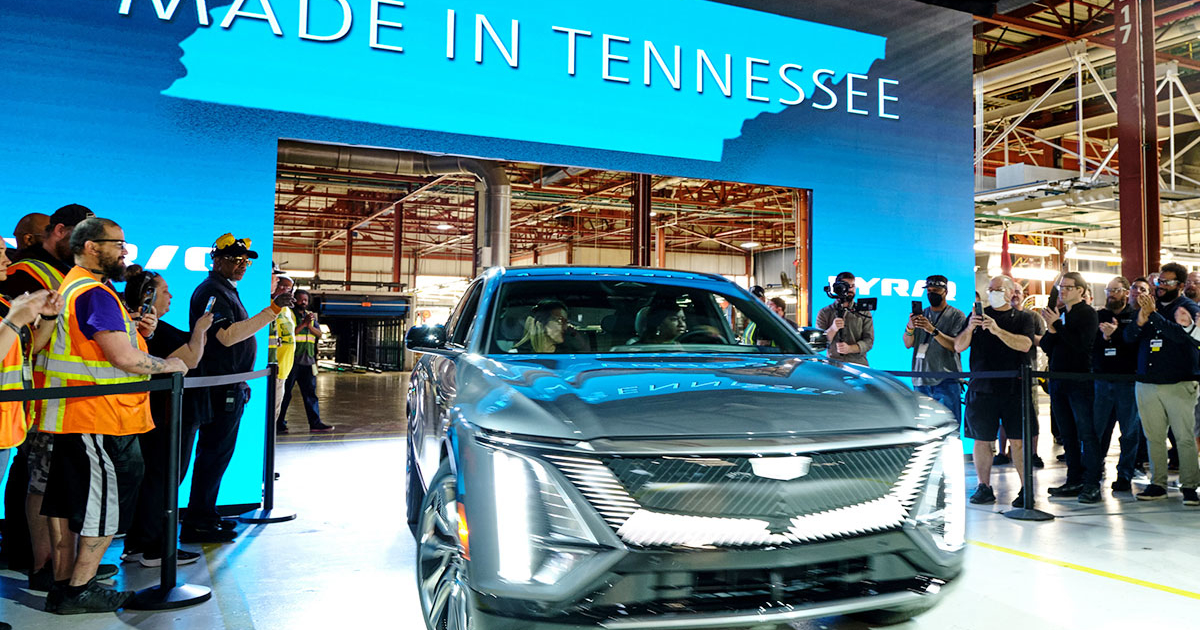
Electric vehicles built in U.S. factories are dominating the domestic EV market, according to new-vehicle registration data from Experian, and the trend is likely to accelerate, given new tax incentives for EV and battery production in North America.
U.S.-made EVs accounted for about 75 percent of new-vehicle registrations in the first 11 months of last year, Experian data shows, and U.S.-based automakers were responsible for nearly all of the local production. The biggest exception was Nissan, with its Tennessee-built Leaf holding a 1.7 percent EV market share.
The manufacturing trend, driven by Tesla, General Motors and EV startups such as Rivian, is good news for U.S. manufacturers and supply chains as the global auto market goes electric over the coming decade, analysts say. The Inflation Reduction Act, signed into law last year, ended the $7,500 EV credit for vehicles made outside of North America.
International automakers are now accelerating plans to assemble EVs in the U.S. and build their supply chains here.
“The emerging EV market opened up a new opportunity to all manufacturers and brands around the world, but the IRA changed that focus,” said Sam Fiorani, vice president of global vehicle forecasting at AutoForecast Solutions.
“The idea of $7,500 per vehicle lit a fire under companies like Hyundai and BMW to speed up their plans to make their EVs in local plants rather than shipping them into the country,” Fiorani added.
U.S. automakers, following in the footsteps of Tesla, are moving quickly to introduce new EV models ahead of international competitors. Ford now makes an electric version of its best-selling F-150 pickup, the Lightning, and Cadillac recently launched the Lyriq midsize crossover. Tesla plans to launch its own pickup, the Cybertruck, later this year.
Asian automakers, which disrupted the U.S. gas-car market starting in the 1970s, have minimal EV sales — with the exception of Nissan and Hyundai Motor Group, which imports its EVs from Korea but has plans to make them in the U.S.
European brands, which once dominated the luxury market, along with Japan’s Lexus, have lost the U.S. luxury crown to Tesla.
While Tesla’s EV market share fell to 64 percent in the 11-month period from 70 percent in 2021, its overall U.S. new-vehicles registrations increased to 431,740 from 303,129 as the EV market rapidly expanded last year.
Tesla does not disclose its U.S. sales results, so experts must estimate the company’s domestic deliveries. Registration data, which lags sales reports by more than a month, offers a more exact look at Tesla’s results.
The overall EV share of total U.S. vehicle registrations rose to 5.4 percent through November, from 3 percent a year earlier, the Experian data shows.
Ford was in second place in the EV race with 7.4 percent of new registrations in the January-November period, Chevrolet was third with 4.7 percent, Kia had 4 percent and Hyundai 3.7 percent, Experian said. Volkswagen was sixth with 2.4 percent, Audi followed with 2.2 percent, and Rivian came in eighth with 1.9 percent.
While Ford’s EV registrations more than doubled compared with the January-November period in 2021, GM had a more modest 26 percent increase. Sales of the Chevrolet Bolt EV and slightly larger Bolt EUV were halted for 6 months last year due to a recall. The low-volume GMC Hummer had just 841 new registrations through November 2022 and the Lyriq had 120.
To be sure, international automakers were already laying the groundwork for U.S. production of EVs and batteries before the Inflation Reduction Act passed. Volkswagen and Mercedes-Benz started delivering U.S.-made EVs late last year, although their numbers were too small to have an impact on the 11-month registration data. That will change this year.
U.S. automakers are also leveraging their Mexican operations for EVs. Ford’s Mexico-made Mustang Mach-E accounted for 5.2 percent of new U.S. EV registrations in the 11-month period. GM is now retooling a crossover plant in northern Mexico for EV production. And Tesla has been talking with officials in the Mexican state of Nuevo Laredo.
But the U.S. remains the center of activity.
Tesla opened its massive Gigafactory Texas in Austin last year and is already seeking regulatory approval for an expansion. Ford began producing the F-150 Lightning in Michigan last year. Rivian opened its first plant in Illinois in 2021, about the same time EV startup Lucid Motors began vehicle manufacturing in Arizona.
Those assembly plants — and others coming from Hyundai, GM, Ford, Stellantis, BMW, Volvo, Polestar — will be fed by local battery plants the automakers are planning with key battery partners.
“This increased domestic EV production, inspired by the IRA, will build the supply chain quicker than anyone previously thought possible,” Fiorani said. “As long as the IRA remains open-ended, without time or volume limitations, the battery and component infrastructure will grow in North America until the market becomes saturated sometime after 2035.”
Among the top 10 EVs sold in the U.S. last year, Tesla’s Model Y led new registrations in the 11-month period covered by the Experian data, with 200,592 vehicles. It was followed by another Tesla, the Model 3, with 175,661. The Mustang Mach-E was third with 34,643, followed by the Tesla Model X at 30,125 and the Model S at 25,362.
Chevrolet’s Bolt EUV was sixth, with 22,421 registrations, the Hyundai Ioniq posted 21,086 and the Kia EV6 delivered 19,163.
VW’s ID.4 notched 16,345 registrations in period and Rivan’s R1T pickup generated 11,637.
In the coveted U.S. luxury market, Tesla expanded its lead over German and Asian rivals, regardless of vehicle fuel type.
For the 11-month period, Tesla’s 431,740 registrations marked a 42 percent increase over the year-earlier period. BMW was in second place with 296,669 new-vehicle registrations for a 6.4 percent decline. Mercedes-Benz posted 247,932 new registrations, for a 0.6 percent drop and Lexus generated 242,611 for a 17 percent decrease.